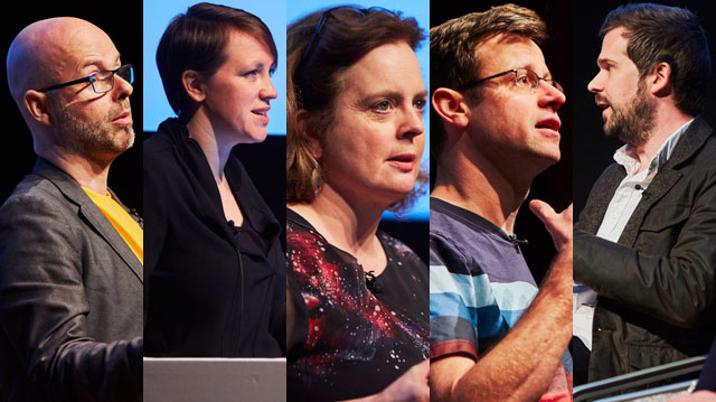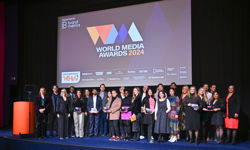
Vanessa Clifford, chief executive of Newsworks, promised that the sixth annual Shift conference would be different, challenging and inspiring, and it was.
To illustrate the need to escape from constant interruptions which disrupted serious thought, creativity specialist Dave Birss took a hammer on stage to destroy a laptop and a mobile phone.
And for the many young agency executives in the audience, in place of the editor of the Daily Telegraph, there was Francesca Marshall, a junior news reporter on the paper, speaking of her excitement at being a journalist and the impact that stories had in print.
More tellingly, the conference was kicked off by someone who was neither journalist, publisher nor advertiser, but a financial specialist – Catherine O’Neill, a director on Citi Research’s European Media Team.
Short termism
She was invited to try to explain what Clifford said was a growing, and fundamental Newsworks theme, “that the pressure to think short-term is actually damaging to brands’ long-term growth” and as a result, to newsbrands.
The macro-economic evidence O’Neill produced on the short-termism in the current digital business environment, and the damage being done to brands and newsbrands, was overwhelming, verging on scary.
The rise of programmatic’s share of digital display spending which has risen from 12.9 per cent in 2012 to an estimated 64.8 per cent this year, had been matched by a move to “passive” computer-driven investment rather than fund managers actively choosing where to place investments. Active investment managers found it difficult to match the performance of passive.
“Such disruption and tensions lead to short termism and filters down the chain of command from shareholders to company boards to company operations,” said O’Neill who noted an associated market preference for cash returns rather than investment for the longer term.
Overall, media spending as a proportion of gross domestic product was falling both in Western Europe and the rest of the world, partly because of a growing trend towards zero-based budgets.
This involved building company budgets from the bottom up rather than allocating any set percentage for marketing.
The Citi analyst noted that the pressures in the system meant that in 2010, the average chief executive lasted 8.3 years but by 2016, it was down to 4.8 years – with chief marketing officers surviving for just three years.
In what begins to look like a perfect storm, $100 billion had been eliminated from advertising spending over the past fifteen years and as a result, the valuation of traditional media companies has suffered.
“Digital was seen as a more affordable and measurable way to advertise,” noted O’Neill who added that although cost cutting had boosted margins, it may have impacted growth and exacerbated structural erosion of business performance.
“Under-investing in brands risks long-term volume declines and loss of market share,” the Citi executive argued.
Moreover, O’Neill went on, at the same time, the “digital halo had slipped” because of the well-known negatives of ad fraud, brand safety, ad blocking and the extent to which digital ads are actually viewed at all.
Given what she said in her powerful analysis, O’Neill was asked whether anything was likely to change as a result?
“Short-termism will continue because people need to continue to show they are delivering results,” she concluded bleakly.
The programmatic effect
On a similar theme, Denise Turner, insight director of Newsworks, warned that the growth of programmatic targeting had led many agencies to downgrade the importance of environment and context with audience exposure being bought at the expense of “the where”.
“A focus on audience targeting, without taking into account the impact of context, could fail to optimise responses,” Turner added.
The Newsworks executive outlined the latest extensive research project to test the hypothesis that publishers offer a quality environment and that they deliver “better results than the run of the internet or the open exchange for advertisers” and are therefore worth a premium.
In a complex enterprise, which is still continuing, more than 200 million impressions have been tagged to measure behavioural and, via panel research, brand response.
Brand and behavioural could thus be compared.
“This will allow us to determine which behavioural metrics – and which combination of those metrics – are best at driving better brand response. Once we know that, we assess how likely those metrics are to be found in the publisher environment versus the run of the internet,” the Newsworks executive explained.
So far, the research suggests the publisher environment is delivering better quality impressions, less likely to have no pixels in view and more likely to be viewed for longer.
And, for instance, when people “hover” over an ad, their brand scores are higher.
Newsworks also threw up interesting numbers on the importance of “the where”.
They include: the fact that 65 per cent of under 35s say that since the rise of fake news, they rely more on established newsbrands, and engagement is 50 per cent higher on premium sites than during general free browsing.
The million-dollar question
At the end of the session, Simon Redican, chief executive of PAMCo, the Publishers Audience Measurement Company, asked a question on many minds.
How come, Redican asked, that despite “furious agreement” at conference after conference on the importance of context, brand safety, return on investment, engagement, the behaviour of the agencies didn’t change and they continued to buy Facebook and Google.
Answer came there very little.
Eva Grimmett, Starcom’s head of strategy UK, acknowledged however it was a debate the industry was now having.
Afterwards, Redican explained in an interview he was more optimistic that the case of “the proven media” on the importance of context, long-term brand building as opposed to the short-termism of digital was being heard in the City and the boardrooms.
He hoped the realisation was growing, backed up by extensive evidence, that the pendulum had been pushed too far down the short-term route.
“When next year’s deal negotiations get under way, the pendulum has to start swinging back the other way otherwise there is something more going on than spending marketing investment where it should be spent,” Redican noted pointedly.
Print works
For one speaker, the pendulum had already swung back in favour of quality print environments.
Louise Newton, group head of marketing at Hotelplan UK told Shift that over the past 9-12 months, there had been a more balanced approach between print and digital.
Newton, a tourism specialist, said she had achieved “phenomenal success” with special print supplements carried in papers such as the Sunday Telegraph.
Much of the rest of the conference was taken up with examining behaviour and the underlying biases that influence us all, and on how you can remove barriers to creativity.
Richard Shotton, deputy head of evidence at Manning Gottlieb OMD has just published The Choice Factory, a study of the biases that influence what we buy.
Shotton told how he had been influenced in one of his campaigns for the NHS by an ancient murder case in New York where 37 people had witnessed the attack but done nothing. They were attacked in the New York Times for their inaction but psychologists found that it was precisely because there were 37 witnesses that none had taken action. There had been a diffusion of responsibility.
Advertising campaigns for blood donors saying blood stocks were low nationally had little effect but saying that blood stocks were low in Birmingham or Bradford did the trick.
“Making people feel they might be personally affected improved the response rate by between 10 and 15 per cent,” said Shotton.
The OMD executive also told how he had asked media agency staff to rate their performance against their peers and 96 per cent of them rated themselves better than their peers.
Birss, who took his hammer to communications technology, also attacked a number of sacred cows.
Brain storming had been shown by countless studies to be a complete waste of time, and the constant interruptions of social media led to a shallowness of thought and negative moods.
The way search algorithms were constructed also meant the most viewed items were pushed to the head of the queue.
“We are likely to get the same information. We are being herded to the same information,” said Birss, whose latest book is Iconic Advantage: Don’t Chase The New, Innovate The Old.
Birss, who said people were better at creative ideas when they were happy, told of an experiment in which creative directors were divided into two groups to produce a campaign tackling binge drinking.
One group had free access to alcohol while the other drank only water.
After three hours, the work of both groups was assessed by senior advertising executives, who did not know about the difference in drinking behaviour.
In a finding likely to delight journalists everywhere, the group on the booze were judged to have come up with the best and most creative work.
Oly Duff, editor of the i national newspaper said he loved working on a hybrid – across print and digital – but that it was print that had the greater impact and “emotional buy-in” with readers compared with the sometimes more ephemeral footprint of digital.
Duff reminded his audience that most national publishers with print at the heart of their business were still making money and that the i itself had made close to £10 million profit last year.
Last up John Crace; the Guardian’s parliamentary sketch writer revealed secrets of a trade that stretches all the way back to Charles Dickens and is still going strong in the digital age.
It was Crace who nicknamed Prime Minister Theresa May the Maybot for her endless repetition of “Brexit means Brexit” and “strong and stable”.
How long will she survive Crace was asked.
His prediction: only until a year before the next election when he will have a new prime minister to satirise.












